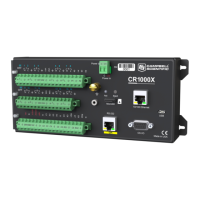The datalogger includes terminals that are configurable for pulse input to measure counts or
frequency as shown in the following image.
Table 6-4: Pulse input terminals and the input types they can measure
Input Type Pulse Input Terminal Data Option
High-frequency
P1
P2
C (all)
l Counts
l Frequency
l Running average of
frequency
Low-level ac
P1
P2
Switch-closure
P1
P2
C (all)
Using the PulseCount() instruction, P and C terminals are configurable for pulse input to
measure counts or frequency. Maximum input frequency is dependent on input voltage (see
Pulse measurement specifications (p. 169) for more information). If pulse input voltages exceed
the maximum voltage, third-party external-signal conditioners should be employed. Do not
measure voltages greater than 20 V.
NOTE:
Conflicts can occur when a control port pair is used for different instructions
(TimerInput(), PulseCount(), SDI12Recorder(), WaitDigTrig()). For
example, if C1 is used for SDI12Recorder(), C2 cannot be used for TimerInput(),
PulseCount(), or WaitDigTrig().
6. Measurements 72

